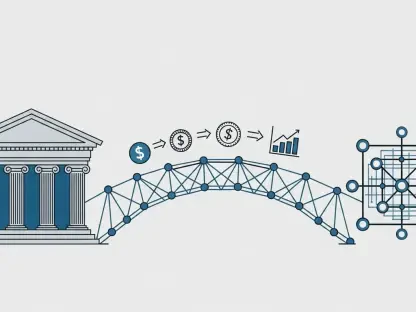In a stunning display of market strength, the U.S. stock indices have recently captivated investors with a remarkable rally, headlined by the Dow Jones Industrial Average soaring over 450 points, a robust 1.04% increase to close at 44,922.27. Alongside this impressive climb, the S&P 500 and Nasdaq Composite achieved consecutive record highs, posting gains of approximately 0.3% and 0.1%, respectively. This surge reflects a wave of optimism sweeping through Wall Street, largely driven by mounting expectations of a Federal Reserve interest rate cut. Recent economic data, coupled with political endorsements for monetary easing, have fueled speculation that lower borrowing costs are on the horizon, spurring investor confidence. Beyond the headline numbers, the financial landscape is buzzing with diverse developments—from individual corporate triumphs and struggles to surprising strength in sectors like cryptocurrency and varied trends in global markets. This intricate mix of factors paints a broader picture of a market at a pivotal moment, balancing exuberance with underlying complexities.
Market Drivers and Economic Indicators
Fed Rate Cut Expectations
The anticipation of a Federal Reserve rate cut at the upcoming September meeting stands as the cornerstone of the recent market rally, with traders expressing near-unanimous confidence in this outcome. According to data from the CME Group, the likelihood of a cut is fully priced into the market, with a growing number of investors betting on a substantial “jumbo” reduction of 50 basis points. This heightened expectation stems from a belief that the Fed will shift toward a more accommodative stance to support economic growth, especially in light of recent signals suggesting a cooling economy. Such a move would lower borrowing costs, making stocks more attractive relative to fixed-income assets, and historically, these conditions have often triggered significant market upswings.
Adding to the momentum, Treasury Secretary Scott Bessent has vocally advocated for aggressive monetary easing, proposing a total reduction of 150 to 175 basis points, starting with a 50 basis point cut in September. This public push from a high-ranking official has amplified market sentiment, as it underscores potential political pressure on the Fed to act decisively. Combined with recent labor market softness, which has raised concerns about an economic slowdown, Bessent’s stance has further convinced investors that relief in the form of lower rates is imminent. This convergence of trader expectations and political rhetoric has created a powerful catalyst, propelling indices like the Dow to remarkable heights in a short span.
Key Economic Data
The recent Consumer Price Index (CPI) report for July has played a pivotal role in shaping the market’s bullish outlook, as it revealed inflation rising less than anticipated despite a slight uptick. This softer-than-expected data has been interpreted as a green light for the Fed to consider rate cuts, reinforcing the narrative that inflationary pressures may be easing enough to warrant policy adjustments. The CPI’s implications extend beyond immediate market reactions, as they suggest a potential shift in the Fed’s focus toward supporting growth over curbing inflation, a balance that has been at the forefront of economic discussions for months.
Looking ahead, investors are keenly focused on upcoming economic releases, including the Producer Price Index (PPI) and retail sales data, both scheduled for later this week. These reports will provide critical insights into inflation trends at the wholesale level and consumer spending patterns, respectively, offering a more comprehensive view of the economy’s health. Should these indicators continue to signal cooling inflation or moderated consumer activity, the case for a Fed rate cut would strengthen further. For now, Wall Street appears to be banking on a dovish response from the central bank, and these data points will either confirm or challenge the prevailing optimism that has driven recent gains across major indices.
Corporate Performance and Sector Trends
Winners and Losers in the Stock Market
Among the flurry of corporate developments, Paramount Skydance Corporation has emerged as a standout performer, with its stock surging by as much as 60% following a landmark $7.7 billion, seven-year deal to become the exclusive U.S. home for UFC events. This strategic move has significantly bolstered investor confidence in the company’s streaming platform, Paramount+, positioning it as a formidable player in the competitive content market. The dramatic stock increase reflects broader market enthusiasm for companies that secure high-value partnerships, especially in entertainment and sports, which continue to draw massive audiences and drive subscription growth.
In stark contrast, CoreWeave, an AI data center company, faced a sharp 18% decline in its stock price after issuing a disappointing Q3 operating income forecast of $160 million to $190 million, falling short of the expected $192 million. High interest expenses and substantial debt concerns have compounded the negative sentiment, highlighting the risks inherent in high-growth tech sectors where financial stability can be precarious. This downturn serves as a reminder that even in a broadly bullish market, individual companies can struggle under the weight of operational and financial challenges, creating a divergent landscape of winners and losers.
Elsewhere, Cava, a fast-casual dining chain, experienced a premarket drop of 23% in its stock value after reporting underwhelming same-restaurant sales growth of just 2.1% and slashing its full-year sales guidance. These figures point to broader economic slowdowns and intensified competition within the dining sector, where consumer spending appears to be tightening. Meanwhile, Apple provided a brighter spot, with shares rising about 1% on news of an ambitious AI comeback plan involving household robots, a revamped Siri, smart speakers, and home-security cameras. Despite a 7% year-to-date decline tied to prior uncertainty over its AI strategy, this development signals potential for renewed investor interest in the tech giant’s innovation pipeline.
Cryptocurrency Boom
The cryptocurrency sector has captured significant attention amid the broader market rally, with Ethereum surging 6% to near-record levels above $4,680 per token. Analysts, including Fundstrat’s Tom Lee, attribute this spike to growing Wall Street enthusiasm and Ethereum’s critical role as infrastructure for numerous crypto projects and stablecoins. This momentum reflects a shift in perception, where digital assets are increasingly viewed as legitimate investment vehicles rather than speculative novelties, a trend that has gained traction amid favorable market conditions and evolving investor sentiment.
Further underscoring the sector’s strength, Bullish, a cryptocurrency exchange operator, successfully priced its IPO at $37 per share, valuing the company at over $5 billion. This achievement marks a strong summer for crypto IPOs and signals robust institutional interest, even as regulatory uncertainties persist in the background. The success of such public offerings highlights the growing integration of cryptocurrency into mainstream financial systems, bolstered by a more supportive policy environment under the current administration. As digital assets continue to carve out a significant space in the investment landscape, their performance adds an additional layer of dynamism to the overall market narrative.
Global Markets and Commodity Pressures
International Market Strength
Turning to the international stage, Japan’s Nikkei 225 has reached an all-time high, fueled by optimism surrounding U.S.-Japan trade agreements and robust performance in the Big Tech sector. Despite some drag from weaker chip and auto industries, the index’s achievement underscores a broader sense of confidence in global economic ties and technological innovation. This milestone reflects how interconnected markets can benefit from positive developments in major economies like the U.S., where domestic rallies often have a ripple effect on international investor sentiment.
Similarly, China’s CSI 300 Index has climbed an impressive 16% since its April low, driven by strong domestic liquidity and a surge in household investments in equities amid persistently low interest rates. Even in the absence of major stimulus measures or finalized U.S. trade deals, the Chinese market has demonstrated resilience, buoyed by internal economic factors. This recovery highlights a divergence in global market dynamics, where domestic policies and investor behavior can sustain growth independently of external uncertainties, contributing to an overarching narrative of global financial stability.
Oil Market Challenges
In contrast to equity market strength, the oil sector is grappling with significant headwinds, as prices have declined amid fears of an industry glut. West Texas Intermediate (WTI) futures have dropped to just above $62 per barrel, while Brent crude has fallen below $65 per barrel, reflecting concerns over oversupply. U.S. crude stockpiles reaching a two-month high have exacerbated these worries, painting a challenging picture for energy markets at a time when other asset classes are thriving. This downturn signals a disconnect between commodity and equity performance, driven by distinct economic fundamentals.
Further compounding the issue, a recent report from the International Energy Agency forecasts a record supply-demand imbalance by 2026, suggesting that current oversupply concerns could intensify in the coming years. This projection raises questions about the long-term sustainability of oil prices and the potential impact on energy-dependent economies. For investors, the divergence between robust stock market gains and weakening commodity prices underscores the importance of a diversified approach, as different sectors respond to unique pressures and outlooks in the global economic landscape.
Investor Sentiment and Political Influences
Market Stability and Confidence
Investor sentiment appears to be riding a high, evidenced by the VIX volatility index—a key measure of market fear—plunging to its lowest level since December 2024 at 14.49. This decline indicates a notable reduction in expectations for significant market swings, suggesting a period of relative calm amid the rally. Many attribute this stability to the substantial cash reserves held by investors, who stand ready to capitalize on any dips, reflecting a proactive approach to market participation that further fuels the ongoing upward momentum.
Another factor bolstering confidence is the emerging strategy dubbed “TACO” (Trump Always Chickens Out), which captures the belief among investors that aggressive tariff threats by President Trump may ultimately be softened. This perception has encouraged continued market engagement, as the fear of disruptive trade policies diminishes. Combined with a growing view that global economic conditions are more resilient than previously anticipated, despite geopolitical and tariff uncertainties, this mindset has created an environment where risk-taking is rewarded, contributing to the sustained strength seen in major indices.
Political and Policy Dynamics
Political developments are adding a layer of intrigue to the financial narrative, particularly with the Trump administration’s active search for a new Federal Reserve chair to replace Jerome Powell, with up to 11 candidates under consideration. This transition introduces uncertainty about the future direction of monetary policy, as a new leader could bring a different perspective on rate cuts and economic stimulus. Such changes at the helm of the Fed often prompt markets to reassess expectations, creating a cautious undercurrent amid the broader bullish sentiment.
Additionally, the administration’s pro-crypto stance has provided a significant boost to the digital asset sector, contributing to recent gains in cryptocurrencies like Ethereum and the successful IPO of Bullish. This policy shift marks a departure from previous regulatory challenges, fostering an environment where innovation in blockchain and digital currencies can flourish. As political influences intersect with economic policy, they shape market dynamics in unexpected ways, reminding investors of the intricate balance between governance and financial outcomes. Looking back, these political undercurrents played a notable role in framing the market’s response to anticipated Fed actions and sector-specific trends.









